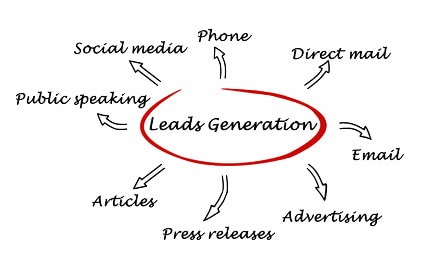Instead of looking at a website as a visual presentation of your services, the main goal is to market your business and get a fast ROI (return of investment).
Unfortunately I see a lot of business websites that are hardly generating sales or attracting new customers, when there’s plenty of opportunities. Whether it is a lack of knowledge, disinterest or the website was just created with the idea that every business needs a website without taking the marketing aspect into consideration, it wonders me. What wonders me if these business owners are aware of how much more sales they can make with an optimized and well maintained website.
I understand that operating your own business is exciting, can be very time consuming and you don’t necessary have time to take on a marketing course. Without taking too much of your time, let me explain the basics of marketing your business online and generate more sales.
What is a lead in marketing terms?
A marketing lead is a person or business that is interested in potentially purchasing your products or services. You can gain more leads by raising awareness of your products or services. For example: you can get more marketing leads through advertisements, trade shows, (street) banners, starting an email subscriber list etc.

Don’t underestimate the potential power in generating more leads when it comes to building your website. If you have a beautiful looking website that runs slow and does not have the right marketing tools in place, it is not likely that it will generate as much leads as it could. Research learns that 88.5% of all Canadian make use of an internet connection in their homes. That’s roughly 32,120,519 potential leads! It is almost a no-brainer that a business without a professional website is missing out on sales.
[bctt tweet=”Learn about marketing leads and conversion rates. It’s easy!”]What is a conversion?
A conversion in marketing terms is when a person responds to a call-to-action. Let’s say you have a form on your website where users can sign up to receive a newsletter. Every new signup is a conversion. But there’s more to it: when somebody actually opens the newsletter you sent out is a conversion. When somebody clicks on a link in the newsletter, that’s a conversion too. Another example is when a customer makes use of a discount coupon that you have sent out. Every respond to a call to action is a conversion, but the ultimate conversion is the one that leads to a sale.
Tracking (measuring) your conversions will help you to see what marketing tools gives you the most conversions and with that information you will be able to calculate your conversion rates.
What is the conversion rate?

Tracking your conversions doesn’t necessary have to be hard. You can easily track how many people have picked up the phone and called you, filled in a form or signed up for your newsletter. So, let’s explain the conversion rate with the conversion being the amount of sales: The total number of sales divided by the number of leads x 100.
For example:
Let’s say you want to know what the conversion rate of your total website leads is:
Take the total number of sales divided by the number of unique website visitors x 100.
For example:
How to calculate the value of a lead
Let’s take the example above where we calculated the conversion rate of your website sales. We calculated a conversion rate of 2.5%. Let’s say you sell clothing. Your average sale per order is $150.-. We can calculate the value of a lead by multiplying the average value of a sale by the conversion rate: Sale: $150.- x 2.5%= $3.75. This means that each lead you get is worth $3.75.
If you have a website where most leads are traceable, it is also possible to break down the total website leads into the lead value by source.
With these numbers, you can then invest more on marketing towards the lead that gives you the best conversion rate.
Determine how many leads you need to keep your business running
Now that you know what the value of each lead is (in our example that’s $3.75), you can determine the amount of leads (in this example we use the website visitors) you will need to sustain your business. If your business needs $8000.- each month to sustain itself, you can then calculate how many leads you will need:
So we need 2.5% (the conversion rate) of 2133 website visitors to make a $150.- purchase each month. That means 53.33 purchases * $150 = $7999.50.
Of course the reality is that the percentage of your sales fluctuates. It will also be very interesting to break down your leads, so you know exactly which lead gives you the maximum percentage in sales. I suggest creating a simple spreadsheet or text document that hold all leads/sales information and calculate the percentage. You can then put more attention towards marketing the channels that will give you the best sales leads.
Using sales leads towards marketing
Like I mentioned above, you can market the leads that will give you the best conversion rate, but you can also decide if your marketing investment is a smart investment. We now know that your average website sales lead is $3.75 and you will need at least 2133 website visitors each month to sustain your business. It does not make sense to invest in a marketing tool that charges $3.75 or more per click = per visitor.
Another important factor to get more (and more profitable) leads is search engine optimization. Getting more organic visitors = more leads = more sales. Make sure you invest in a good search engine optimization specialist that will take your leads and conversion rate into consideration when optimizing your website for certain keywords. You want them to focus on high quality keywords for your business niche that will send the most profitable traffic to your website
I am sure that once you get the hang of it and you start to get more sales, you start to love working with these numbers and know exactly what’s going on with your business.
Other Resources
https://en.wikipedia.org/wiki/Lead_generation
http://www.businessdictionary.com/definition/sales-lead.html
Did you find this helpful, do you have questions? Don’t hesitate to tell me your experience or ask questions. There’s no such thing as strange questions and it will be my pleasure to help.




